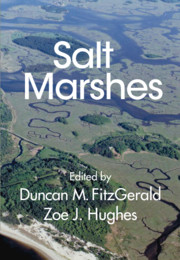Book contents
- Salt Marshes
- Salt Marshes
- Copyright page
- Contents
- Contributors
- Acknowledgments
- 1 State of Salt Marshes
- Part I Marsh Function
- Part II Marsh Dynamics
- 7 Marsh Equilibrium Theory
- 8 Salt Marsh Ecogeomorphic Processes and Dynamics
- 9 Salt Marsh Sediments as Recorders of Holocene Relative Sea-Level Change
- 10 Storm Processes and Salt Marsh Dynamics
- 11 Understanding Marsh Dynamics
- 12 Understanding Marsh Dynamics
- Part III Marsh Response to Stress
- Index
- References
8 - Salt Marsh Ecogeomorphic Processes and Dynamics
from Part II - Marsh Dynamics
Published online by Cambridge University Press: 19 June 2021
- Salt Marshes
- Salt Marshes
- Copyright page
- Contents
- Contributors
- Acknowledgments
- 1 State of Salt Marshes
- Part I Marsh Function
- Part II Marsh Dynamics
- 7 Marsh Equilibrium Theory
- 8 Salt Marsh Ecogeomorphic Processes and Dynamics
- 9 Salt Marsh Sediments as Recorders of Holocene Relative Sea-Level Change
- 10 Storm Processes and Salt Marsh Dynamics
- 11 Understanding Marsh Dynamics
- 12 Understanding Marsh Dynamics
- Part III Marsh Response to Stress
- Index
- References
Summary
Salt marshes are considered some of the most biologically diverse and ecologically important regions on Earth, containing thousands of species of robust salt-tolerant plants, crabs, fish, mollusks, zooplankton, algae, and bacteria. Isolated between topographic headlands, laterally continuous behind protective barriers, or associated with extensive delta landscapes, salt marshes are regulated by a variety of physical forces such as waves, tides, rivers, and storm surges, but they are also impacted by climatic variations in temperature and precipitation, riverine flooding, local tectonics, and subsidence (i.e., a deltaic process that describes the lowering of the land surface). Biological forces also play important roles in controlling salt marsh landscapes as many species shape geomorphic development. As these landscapes form and evolve, there exist significant interactions between biology, hydrology, and geology; thus it is impossible to consider salt marsh geomorphology – i.e., how the landscape changes over time – without taking into account these principal interactions.
Keywords
- Type
- Chapter
- Information
- Salt MarshesFunction, Dynamics, and Stresses, pp. 178 - 224Publisher: Cambridge University PressPrint publication year: 2021
References
- 1
- Cited by

